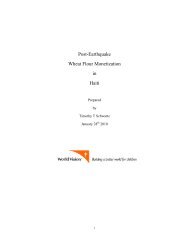Right to Livelihoods in Haiti
Focus on egg production and rural household livelihood strategies
Focus on egg production and rural household livelihood strategies
You also want an ePaper? Increase the reach of your titles
YUMPU automatically turns print PDFs into web optimized ePapers that Google loves.
24<br />
The best way <strong>to</strong> turn these opportunity po<strong>in</strong>ts <strong>in</strong><strong>to</strong> profits is through and program that emphasizes<br />
local technology and improved access <strong>to</strong> new, low cost technologies from abroad, i.e. a<br />
decentralization of the technologies necessary for chicken production (see ‘Strategies’ below)<br />
A major advantage is that <strong>Haiti</strong>ans are so poor: 80% of the population depend on flexible household<br />
strategies where family labor is readily available and labor costs <strong>in</strong> terms of money are extremely<br />
low. This means that if we can f<strong>in</strong>d ways <strong>to</strong> allow <strong>Haiti</strong>ans <strong>to</strong> <strong>in</strong>corporate egg production strategies<br />
<strong>in</strong><strong>to</strong> their ongo<strong>in</strong>g household livelihood strategies then cost of labor and even cages and<br />
ma<strong>in</strong>tenance can be considered close <strong>to</strong> zero.<br />
Another important advantage not emphasized <strong>in</strong> this report is that the big payback for the<br />
producers comes with sell<strong>in</strong>g the layers. Unlike <strong>in</strong> developed markets, an old hen that no longer<br />
produces eggs has a value for meat equal <strong>to</strong> that of any other hen. This means that an producer who<br />
has 200 layers, succeeds <strong>in</strong> cover<strong>in</strong>g costs through egg production but does not make a profit at that<br />
stage, can sell the layers after a 1 year lay<strong>in</strong>g cycle and make US $2,000, a figure almost triple the<br />
<strong>Haiti</strong>an per capita GDP.<br />
Strategy<br />
A strategy that may effectively help the <strong>in</strong>dustry overcome constra<strong>in</strong>ts should focus on access <strong>to</strong> the<br />
raw materials, the chickens, feed, cages, availability and distribution of those materials.<br />
o<br />
o<br />
o<br />
Feed: the biggest po<strong>in</strong>t of entry <strong>in</strong> terms of a new ‘economy of egg’ production is promot<strong>in</strong>g<br />
local feed specialists who produce high prote<strong>in</strong> worms and bugs (vermiculture) as well as<br />
plant<strong>in</strong>g, harvest<strong>in</strong>g and process<strong>in</strong>g hi-pro weeds that chickens like <strong>to</strong> eat. This would help<br />
resolve the problem of the distribution and availability of high prote<strong>in</strong> feed. Indeed,<br />
everyth<strong>in</strong>g that can be done <strong>to</strong> reduce costs of imported feed will <strong>in</strong>crease profits. To support<br />
micro-producers of feed, the <strong>in</strong>itial program would purchase the products straight from the<br />
new feed producers, assur<strong>in</strong>g them a profit for their efforts and kick-start<strong>in</strong>g the production<br />
process.<br />
Cages: The most obvious local option <strong>to</strong> imported wire<br />
coups are local bamboo cages. A read technology found<br />
throughout <strong>Haiti</strong> that could be used for chicken coups are<br />
bamboo fish traps. Fish traps are sold <strong>in</strong> the markets as<br />
kits. The buyer puts them <strong>to</strong>gether. The same could be<br />
done for chicken coups. What this means is that so me one<br />
who wanted <strong>to</strong> <strong>in</strong>vest <strong>in</strong> eggs could buy the cage <strong>in</strong> the<br />
market, take it home and put it <strong>to</strong>gether. Those cages are<br />
<strong>in</strong>expensive, US $2 <strong>to</strong> $5, depend<strong>in</strong>g on the size. The fish<br />
traps themselves will hold 5 <strong>to</strong> 20 chickens, aga<strong>in</strong>,<br />
depend<strong>in</strong>g on the size.<br />
Hatchl<strong>in</strong>gs: A promis<strong>in</strong>g new development that has<br />
occurred <strong>in</strong> the US and Europe are s a k<strong>in</strong>d of is a<br />
revolution <strong>in</strong> hobby egg <strong>in</strong>cuba<strong>to</strong>rs. The availability of solar<br />
Fisherman putt<strong>in</strong>g <strong>to</strong>gether a fish<br />
trap that could just as effectively<br />
hold 20 <strong>to</strong> 30 hens<br />
or battery powered <strong>in</strong>cuba<strong>to</strong>rs could put a new class of <strong>Haiti</strong>an small entrepreneurs <strong>in</strong><strong>to</strong> the<br />
bus<strong>in</strong>ess of micro-hatcheries, help<strong>in</strong>g <strong>to</strong> resolve the problem of the distribution and<br />
availability of layers outside of Port-au-Pr<strong>in</strong>ce.
















